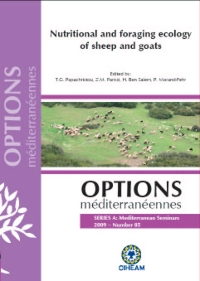| Article précédent | p. 431-436 | Article suivant |
Compared in vitro anthelmintic effects of eight tannin-rich plants browsed by goats in the southern part of France
The search for alternative solutions to chemical treatments is nowadays prompted by the emergence and widespread diffusion of resistance to anthelmintics in populations of gastrointestinal nematodes in sheep and goats. Experimental evidence is accumulating to suggest that tannin-rich plants have anthelmintic properties and may therefore represent a possible alternative option to control nematodes. However, most data have been acquired on legume forages. In contrast, information on plants browsed by goats (or sheep) remains scarce. The anthelmintic properties of a range of concentrations of 8 plant extracts: chestnut (Castanea sativa), pine tree (Pinus sylvestris), heather (Erica erigena), genista (Sarothamnus scoparius), brambles (Rubus fructicosus), oak tree (Quercus robur), hazel bush (Corylus avellana) and ash tree (Fraxinus excelsior) composing browse in the South of France have been examined on the 3 main nematode species of small ruminants (i.e. Teladorsagia circumcincta, Haemonchus contortus and Trichostrongylus colubriformis), using two in vitro assays: (i) the larval migration inhibition assay on third-stage larvae (L3); and (ii) the adult worm motility inhibition assay. The tannin contents of the plant were measured according to the method of the European Pharmacopea. The results indicated that total tannin contents ranged from 24.7% DM to 1.5%. All plants showed some anthelmintic activity in both stages. However, variations in efficiency were observed depending on the parasitic stages (L3 vs adult worms) or species. Overall, the most consistent results were found with plant extracts possessing the highest tannin content (oak tree, hazelnut, chestnut and brambles respectively).
La recherche de solutions alternatives aux anthelminthiques chimiques est désormais un impératif pour gérer les nématodes gastrointestinaux parasites des petits ruminants compte tenu de la diffusion constante des résistances aux anthelminthiques dans les populations de vers. Plusieurs données récentes suggèrent que des plantes riches en tannins possèdent des propriétés anthelminthiques et pourraient représenter une solution alternative pour la maîtrise de ce parasitisme. Cependant, ces données ont surtout été acquises sur des légumineuses fourragères. Les informations sur les propriétés antiparasitaires de plantes de parcours ou de sous-bois exploitées par les chèvres ou les moutons restent rares. Les effets d'une gamme de concentrations d'extraits de 8 plantes [châtaignier (Castanea sativa), pin sylvestre (Pinus sylvestris), bruyère arborescente (Erica erigena), genêt à balai (Sarothamnus scoparius), ronce (Rubus fructicosus), chêne (Quercus robur), noisetier (Corylus avellana), frêne (Fraxinus sp.)] présentes sur les couverts pastoraux du sud de la France ont été examinés, sur 3 espèces parasites de petits ruminants, en utilisant deux tests in vitro : (i) le test d'inhibition de migration larvaire sur les larves infestantes ; et (ii) le test d'inhibition de motilité des vers adultes. Les teneurs en tannins des plantes, mesurées selon la méthode de la Pharmacopée Européenne, indiquent des valeurs allant de 24,7% à 1,5% de la MS. Tous les extraits ont montré une activité anthelminthique sur les 2 stades. Cependant, de fortes variations d'efficacité ont été notées selon le stade (L3 ou vers adultes) ou l'espèce concernée. De manière générale, les résultats les plus constants ont été trouvés avec les plantes présentant les plus fortes teneurs en tannins (chêne, noisetier, châtaignier, ronces).
- [ Afficher ]
- [ Télécharger ]
- [ Exporter la citation ]
Vous pouvez télécharger la citation au format :
- [ Imprimer ]
-
Mots-clés
ANTHELMINTHIQUE, CAPRIN, CASTANEA SATIVA, CYTISUS SCOPARIUS, EXPERIMENTATION, NEMATODOSE, OVIN, PINUS SYLVESTRIS, PLANTE A TANNIN, PROPRIETE BIOLOGIQUE, QUERCUS ROBUR, RUBUS FRUTICOSUSCiter cet article
Hoste H., Brunet S., Paolini V., Bahuaud D., Chauveau S., Fouraste I., Lefrileux Y. Compared in vitro anthelmintic effects of eight tannin-rich plants browsed by goats in the southern part of France. In : Papachristou T.G. (ed.), Parissi Z.M. (ed.), Ben Salem H. (ed.), Morand-Fehr P. (ed.). Nutritional and foraging ecology of sheep and goats. Zaragoza : CIHEAM / FAO / NAGREF, 2009. p. 431-436. (Options Méditerranéennes : Série A. Séminaires Méditerranéens; n. 85). 12. Seminar on: Nutritional and Foraging Ecology of Sheep and Goats, 2007/10/11-13, Thessaloniki (Greece). http://om.ciheam.org/om/pdf/a85/00801039.pdf



